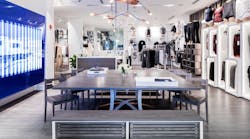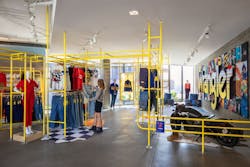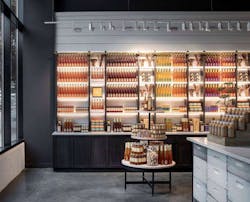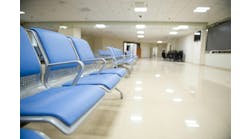Specifying for the retail market is quite different from other sectors within interior design. If you are new to this side of the industry, you’ll quickly realize that retail is one of the fastest-paced markets in design. As soon as you get the green light from the client, you have only a matter of months to design and build before the store is set to open. These quick timelines are ultimately the largest driving factor differentiating retail specifying from other market sectors.
Customizing
Retail does not always provide the luxury of allowing one to customize finishes or furniture in markets like residential and hospitality. If the project is a “one-off” retail store, it’s unlikely that you’ll meet a square footage minimum to customize finishes like carpet or upholstery. This isn’t a hard-and-fast rule but keep it in mind.
If you’re working on a prototype, however, creating a customized finish solution may be a possibility if it will be rolled out in all new stores using the design. There are times when certain manufacturers allow customizations to be created for a smaller or lower quantity but lead time could be an issue. If you do pursue a custom solution, keep the timeline in mind and work with the manufacturer as early as you can.
Durability
A designer must always consider worst-case durability scenarios when specifying finishes in retail. Shoes tracking in dirt, strollers bumping along fixtures and sales associates pushing carts around corners are just a few of the daily occurrences. Finishes should be exceptionally resilient to avoid the need for frequent and/or costly repairs.
A designer should look to their local sales representative or go straight to the manufacturer to ensure the material is suitable for retail applications. Representatives always want the specifier and client to be happy with their product and won’t suggest a material that can’t hold up.
Installation may also be specific to the material, so designers should verify if there are any unique requirements during application that would cause a material to fail. Different climates offer weather-related challenges, so finishes like walk-off mats or non-slip floors may be necessary in order to provide a safe environment.
Sustainability and Lifespan
Due to the nature of retail turnover and brand refreshes, the lifespan of materials is shorter than in other market sectors. Every brand varies but you can expect the majority to refresh their stores every few years to incorporate the latest design trends—something every designer should consider when specifying products. Unlike other markets where designs are intended to last many years, retail design’s shelf life is considerably shorter.
While more permanent finishes like flooring may be durable and timeless, surfaces like walls can be redesigned to look completely different with just a swap in color, texture or pattern. These frequent renovations tend to lead to a fair amount of waste, as finishes still in good condition are replaced with a trendier version.
[Related: How to Specify: Sustainable Furniture ]
Due to the frequency of retail renovations, you should be sure to discuss sustainability considerations with your client. While clients may want to invest as little as possible in materials they think they’ll be replacing in only a few short years, specifying more sustainable materials can help minimize the store’s negative environmental impact. These could include materials made with recycled content, made from rapidly renewable resources or made from FSC-certified wood.
It’s also important to find out if the products you’re specifying have manufacturer takeback programs so when they are replaced, they can be kept out of landfills or possibly repurposed. Typically, you can find products with sustainable attributes that are comparable in price.
Health and Wellness
Another rapidly evolving area of focus for designers is health and wellness and selecting products and materials that have been verified to minimize the use of substances harmful to human health. Many manufacturers are embracing transparency and providing information on their products’ ingredients and human health impacts.
It is important for designers to select products that minimize employees’ and shoppers’ exposure to toxic ingredients and to specify products that have various certifications such as Health Product Declarations (HPDs) or that are Red List Free.
The retail industry is an exciting world to be a part of, filled equally with unique challenges and creative solutions. The quick timeline from start to finish, the frequent renovations and the rapidly changing nature of bricks and mortar retail give designers an opportunity to think about the impact of their material selections in an entirely different light than with other market sectors.
Listen Next: Rethinking and Reimagining Retail in Light of COVID-19




